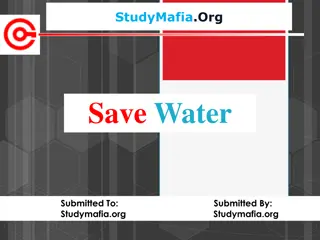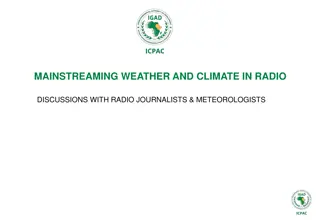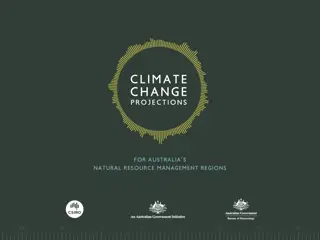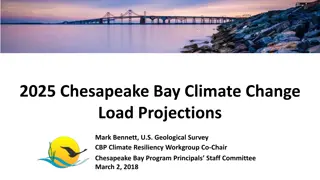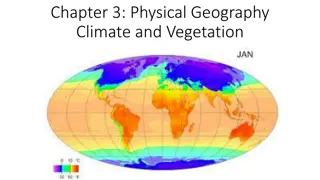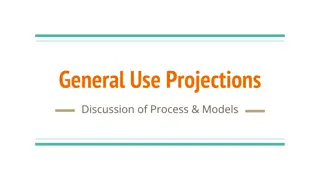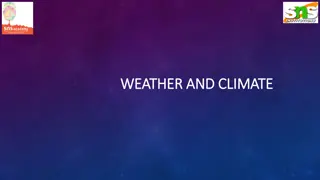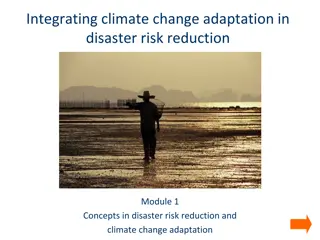Integrating Stochastic Weather Generator with Climate Change Projections for Water Resource Analysis
Exploring the use of a stochastic weather generator combined with downscaled General Circulation Models for climate change analysis in the California Department of Water Resources. The presentation outlines the motivation, weather-regime based generator description, scenario generation, and a case study on State Water Project Delivery. It discusses the impact of climate change on water systems, emphasizing the importance of preparing for future hydroclimate fluctuations. The generator is based on weather regimes that organize mid-latitude storms, providing insights into long-term trends and variability.
Download Presentation

Please find below an Image/Link to download the presentation.
The content on the website is provided AS IS for your information and personal use only. It may not be sold, licensed, or shared on other websites without obtaining consent from the author. Download presentation by click this link. If you encounter any issues during the download, it is possible that the publisher has removed the file from their server.
E N D
Presentation Transcript
C A L I F O R N I A D E P A R T M E N T O F W A T E R R E S O U R C E S Current Climate Change Analysis Practices in DWR s using the Latest Climate Change Projections and a Weather Generator May 17th, 2024 C-DAWG Romain Maendly Climate Action Coordinator CA DWR / Executive Division
Presentation Outline 1. Motivation Why combine a stochastic weather generator and downscaled General Circulation Models directly? 2. Weather-Regime Based Stochastic Weather Generator Basic description of the weather generator 3. Scenario Generation Demonstration of climate change scenarios generation with the Stochastic Weather Generator model 4. Latest Use Case Draft State Water Project Delivery Capability Report 2023
Why combine a stochastic weather generator and downscaled General Circulation Models directly?
Planning Water Systems for Future Climate Conditions Realized Hydroclimate: + Noise (Natural variability) Signal (Climate change trends) Magnitude, frequency, timing, and sequencing of droughts and floods Shifting snow accumulation / melt dynamics, rain-on-snow Long-term, quasi- or aperiodic dry periods and pluvials Higher ET and soil moisture loss Intensification of extreme precipitation Space-time distribution of precipitation and temperature across a heterogeneous landscape Shifts in location and frequency of storm tracks
2. Weather-Regime Based Stochastic Weather Generator
Weather Regime Based Stochastic Weather Generation Weather Regime - Mid latitude atmospheric intra seasonal variability is characterized by large scale flow patterns ( weather regimes ) Organize mid latitude storms Appear repeatedly at fixed geographical locations Persist beyond the lifetime of individual synoptic scale storms (days-weeks) Exhibit rapid transitions associated with nonlinear atmospheric dynamics Respond to external forcings (e.g., ENSO or anthropogenic effects)
Process-Based Understanding of Climate Change Thermodynamic VS. Dynamic Shifts in location of storm tracks Shifting snow accumulation / melt dynamics, rain-on-snow More frequent storm events Higher ET and soil moisture loss Shift in the frequency, duration, or transition probabilities of weather regimes Intensification of extreme precipitation Changes in the dynamics of ENSO
Weather Regimes Support California-Wide Model Development and Deployment Perturbed Historical Time series (1915- 2018) Inputs: Livneh Untrimmed Precipitation & Livneh Detrended (1991-2020) Temperature Outputs: 23 Scenarios based on the historical period (Tmin, Tmax and Precip) with extreme precipitation scaling of 7% per C. WGEN Thermodynamic Time Series Only Inputs: Same as above, trained on the historical period (1948-2018) Outputs: o 1,000year daily weather-generated data (Tmin, Tmax and Precip) o 23 scenarios with extreme precipitation scaling of 7% per C, +6 scenarios for sensitivity analysis
Bottom-Up Climate Vulnerability Analysis with a Stochastic Weather Generator
Bottom-Up Climate Vulnerability Analysis with a Stochastic Weather Generator (2)
State Water Project (SWP) Delivery Capability Report Bi-annual report of Existing and Future delivery capability Key Planning Information for SWP water users (UWMP, IRWM, SGMP, AWMP, etc.) Serve as the default climate change scenario for SWP planning (future energy resource, asset maintenance and management studies, EIR, etc.)
Link Stress Test and Climate Space and Assess Risk
Model/Data Availability and Resources DWR Climate Change Program Website: Resources for Water Managers https://water.ca.gov/Programs/All- Programs/Climate-Change- Program/Resources-for-Water-Managers Final Report California Natural Resources Agency Data Library: https://data.cnra.ca.gov/dataset/ca- weather-generator-gridded-climate-pr- tmin-tmax-2023 Weather Generator Tool Public Seminar YouTube Channel: https://www.youtube.com/watch?v=QQZ1 MIoC2_0
Thank you! Romain.Maendly@water.ca.gov







